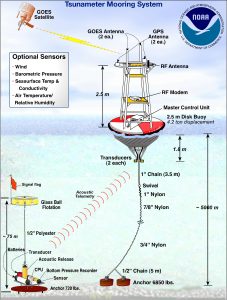Introduction
Our group did the research of natural disaster prevention strategies of Tokyo 2020 through four aspects, early warning systems, prevention procedures, evacuation, and post-disaster management. The 32nd Summer Olympic Games and the 16th Summer Paralympic will be held in Tokyo, from July 24th to August 9th, 2020 and August 25th to September 6th, 2020 respectively (Tokyo2020).

https://upload.wikimedia.org/wikipedia/commons/thumb/f/f2/Tokyo_2020_Olympics_logo.svg/1200px-Tokyo_2020_Olympics_logo.svg.png

https://upload.wikimedia.org/wikipedia/commons/thumb/b/bb/New_2020_Summer_Paralympics_Emblem.svg/1200px-New_2020_Summer_Paralympics_Emblem.svg.png
Brief Introduction of Our Projection
Initially, Tokyo is a coastal city. It is located in the southern part of the
Kanto plain in Honshu with a large population (Karan, 2005). It is also situated on the boundary of Eurasian plate and the Pacific plate (Karan, 2005). These two reasons make Tokyo prone to several disasters, such as earthquakes, tsunamis, as well as volcanic eruptions (Ministry of Finance Japan, 2017).
Early Warning System
The Japan has Early Warning System (EWS) of earthquake reporting, which is provided by the Japan Meteorological Agency (JMA). It collects seismic data from a network of over one thousand seismographs nationwide and provides estimates of seismic intensities along with a rough arrival time o the principal motion. Deep-Ocean Assessment and Reporting Tsunami (DART) monitors tsunami, which developed by the National Oceanic and Atmospheric Administration (NOAA) in the United-States. It comprised of over thirty-nine buoy-mounted detection systems, measures ocean pressure in tandem with sea-surface height estimates to provide advanced warnings on developing tsunamis.

http://www.noaanews.noaa.gov/stories2005/images/tsunami-dart-system.jpg
Evacuation
Japan has devised the Basic Plan for the Promotion of Tokyo Inland Earthquake Emergency Countermeasures (the TIE Basic Plan) by The Tokyo Metropolitan Government (TMG), which calls for the construction of systems to ensure the sustaining of the pivotal functions of the central government and the building of earthquake resilient communities.
Post-Disaster Management
The Japanese government has established an Earthquake Insurance System in 1966 for indemnifying natural disasters such as earthquakes and tsunamis, as well as the volcanic eruptions (Ministry of Finance Japan, 2017). There are three approaches of post-management in Japan: self-rescue, government assistance, and social relief.
Conclusion
Japan has detailed and well-organized early warning system, evacuation and post-disaster management strategies for coping with natural disasters. However, due to the increase in people amount in and around Tokyo. the government needs to and has to put the large effort into disasters prevention.

https://ichef-1.bbci.co.uk/news/624/cpsprodpb/4ADB/production/_87336191_6ff6e307-9a72-4ab8-8096-05f77ec04e95.jpg
Weaknesses and Concerns
The Kantō Great Earthquake of 1923 (the magnitude of 7.9) brought a painful lesson to the Japanese nation and gave Japan’s disaster prevention work a profound impact. Therefore, in the later disasters prevention plan, Japan paid a special attention to the establishment of urban shelters, fire belt construction around rivers and parks, the community disaster prevention base planning, which gradually formed a relatively integrated and well-organized disasters prevention system.

http://devastatingdisasters.com/wp-content/uploads/2015/04/the-great-kanto-earthquake-1923.jpg
Until 2016, The population of Tokyo had an estimated population of 9262.046 in 2,191 square kilometers (Tokyo proportion) which Tokyo is in high population and high population density. Moreover, Japan has an average of four earthquakes per day. However, my concern is that How would those disasters prevention systems work during the Paralympic? The public attention of the Paralympic Games may not be as high as the Olympics. But it is certain that the number of tented people around Tokyo and in Tokyo will still increase, and the hardest and most important thing, how to ensure the safe evacuation of the Paralympic athletes if any natural disaster happens during the Paralympic? Those physically or mentally disabled people even need assistance in their daily life. Additionally, the disasters prevention system still has drawbacks, which may not alarm in time.
According to the Basic Plan for the Promotion of Tokyo Inland Earthquake Emergency Countermeasures, the Japan government is increasing the existing emergency response structures in order to fit Games. If any natural disaster happens, all people in the Tokyo stadium will evacuate to the nearest shelter. This means, the Japanese government need to and has to be fully prepared before the start of the Paralympic and promote disasters prevention knowledge to all participants and athletes of the Paralympic.
Fortunately, Japan has rich practiced experience and matured disaster prevention system. Before the Games, people can go to the website: http://www.mlit.go.jp/river/bousai/olympic/en/index.html, to find any disasters prevention information. I wish both the Games a complete success.


https://tokyo2020.jp/en/assets/upload/20170925-1000daystogo-top-sp.jpg
Reference
Japan Meteorological Agency. Earthquake Early Warning System, 2017, Retrieved from:
http://www.jma.go.jp/jma/en/Activities/eew.html .
Ministry of Finance Japan. (2017). Outline of Japan’s Earthquake Insurance System.
Retrieved from: http://www.mof.go.jp/english/financial_system/
earthquake_insurance/outline_of_earthquake _insurance.html
National Oceanic and Atmospheric Administration. Deep-ocean Assessment and
Reporting of Tsunamis (DART) Description, 2017. Retrieved from: http://
www.ndbc.noaa.gov/dart/dart.shtml
P.P. Karan (2005) Japan in the 21st Century: Environment, Economy and Society,
Lexington, The University Press of Kentucky.
The Scenerio-Based Plan for a Large-Scale Earthquake in Tokyo Metropolitan Area.
(2013). Asia-Pacific Economic Cooperation. Retrieved from: http://www.apec-
epwg.org/public/uploadfile/act/13_epwg_sdmof_007.pdf
Tokyo 2020 Overview Outline of the Organizational Plan and Tokyo 2020 Paralympic
Games. Tokyo2020. Retrieved from: https://tokyo2020.jp/en/games/plan/